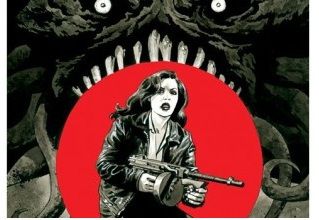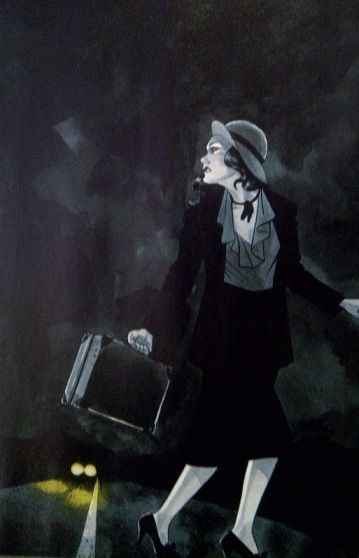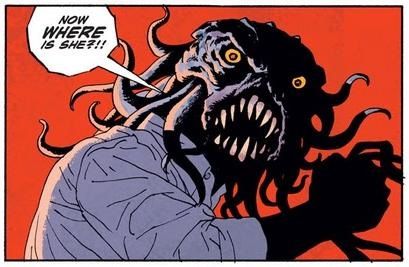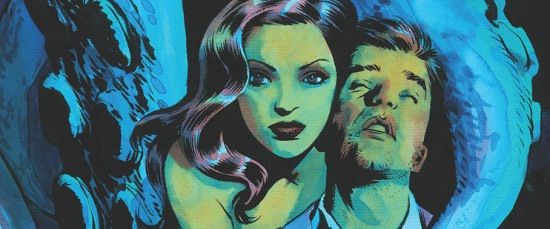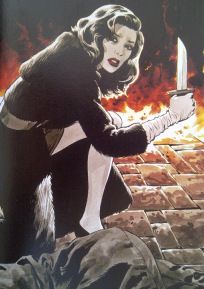(Here's a piece by Kaitlin Tremblay that originally appeared on her site That Monster. Kaitlin's a really interesting writer and she'll be posting/cross-posting some pieces here going forward. - BC)
It’s no secret how much I love Fatale by Ed Brubaker and Sean Phillips. I’ve talked before about how Phillips’ art is one of my all-time favourites, because technique-wise it’s very good and creates the perfect atmosphere for a supernatural noir style narrative. But like any film noir, the story would be incomplete with the dazzling, mysterious and dangerous heroine. But Jo isn’t just the just the femme fatale; she also embodies a lot of what Barbara Creed discusses as the monstrous feminine, while at the same time reversing this typical association and marking the men in the narrative as abject and monstrous.
For Creed, the monstrous feminine is crucially linked by Freud to fears of castration and sexual difference: these female characters become so fearsome and disgustingly terrifying in the threat they represent to machismo. And Jo, the femme fatale who men fall head over heels for and ultimately ruin their lives for, represents this anxiety to the nines. She is beautiful, sexy, alluring, and leaves a wake of dead bodies in her path.
Beyond the typical castration-anxiety of femme fatales, the monstrous feminine is predicated on women in horror films typically being associated with the abject (which, according to Julia Kristeva, is that which threatens or disturbs the social order). As Creed explains, “the horror film abounds in images of abjection, foremost of which is the corpse, whole and mutilated, followed by an array of bodily wastes such as blood, vomit, saliva, sweat, tears, and putrefying flesh.” The abject is all that is necessarily to life, but which is excessive and disturbing of our sense of self: when we think of ourselves as subjects, we don’t consider the bodily wastes that are necessary for our health.
What I find the most interesting about Fatale is the reversal of signs of abjection: Jo is decidedly rather “clean” throughout the first ten issues of Fatale – she is never marked with the usual signs of abjection (bodily excretions), and close-ups on her mouth, face and body paint her as the object of male desire. Despite her own body remaining unmarked by signs of the abject, she is intimately associated with all signs of the abject throughout the narrative: she kills people and leaves them a mess of gore and blood. Significantly, it is the men she encounters who become marked with the signs of abjection.
The first scene of gore is a man’s brains exploding after Jo shoots him in the head. Until Hank meets her, the narrative is clean: there is the funeral, but no bleeding, decomposing bodies yet. Later on, Jo confronts the man who has been the biggest danger to date in the story, and she immediately marks him with signs of the abject: she calls him out on pissing himself, situating him as the object of abject, not herself. Aside from physical violence, there is the violence wrought by men’s desiring of her, as signalled in her lipstick smudge on Hank’s collar: it is a mark of feminine excess, specifically linked with sexuality, which creates the rift between Hank and his wife.
While Jo may not fully embody the monstrous feminine, her involvement in the lives of the men around her situation them as abject, and thus make them monstrous. Her position as the femme fatale creates a counterposition for the men in the story as monstrous. Creed talks about the monstrous feminine as being that which prevents the male from taking their presumed place in the Symbolic order (thus for Kristeva the mother is monstrous because she threatens to restrain the child and prevent them from entering the typical masculine order). Jo’s impact on the men in the narrative create this disruption: Hank, rather than being the hero cop and proud husband and father, descends into an obsessive life of near-madness and disrepute.
Creed goes on to explain that:
“In some horror films, the monstrous is produced at the border between human and inhuman, man and beast; in others the border is between the normal and the supernatural, good and evil; or the monstrous is produced at the border which separates those who take up their proper gender roles from those who do not and abnormal sexual desire.”
Jo’s violence sets her up at the border for the readers. She is human, but not. She is good, but evil. She is marked by the stereotypical signs of femininity, but she is more three-dimensional than just the femme fatale. Jo exists exclusively in this liminality, fluctuating between subject positions depending on the situation: she is good when she saves the day, but evil when she ruins people’s lives. She is the monstrous feminine in her representation of the castration anxiety, but she also marks men with the typical signs of abjection and the monstrous feminine.
The gender dynamics are in flux: she is damsel, she is heroic, and this is what I love about Fatale (other than the fact that it’s a Lovecraftian noir, of course). She is monstrous, and she makes others monstrous. She embodies castration anxiety, but she is also sexualized in a fairly stereotypical way. She is both the monster and the only hope for salvation, and that is the source of much of the terror of the narrative.

